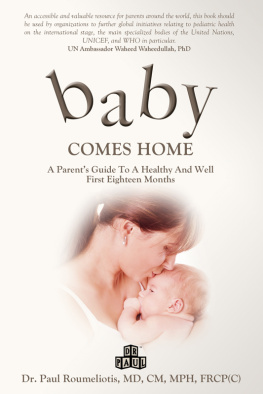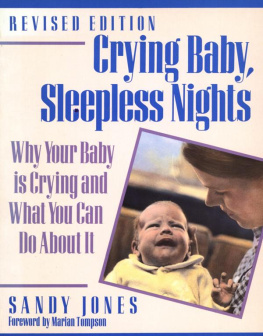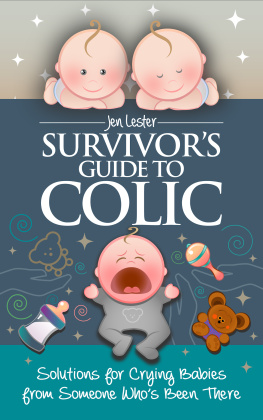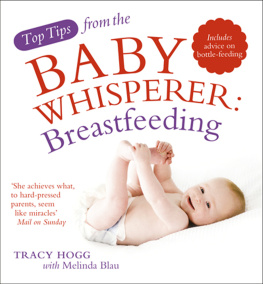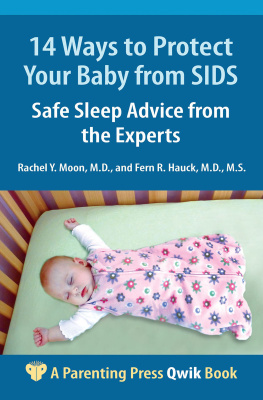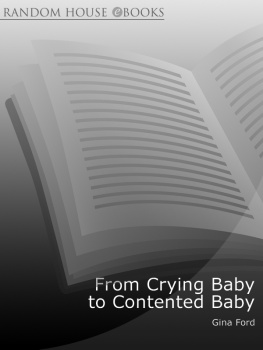

Copyright 2014 by James Peinkofer, LCSW
All rights reserved. No portion of this book may be reproduced or transmitted in any form whatsoever, including electronic, mechanical or any information storage or retrieval system, except as may be expressly permitted in the 1976 Copyright Act or in writing from the publisher.
Requests for permission should be addressed to:
New Horizon Press
P. O. Box 669
Far Hills, NJ 07931
James Peinkofer, LCSW
Losing Patience:
The Problems, Alarms and Psychological Issues of Shaken Baby Syndrome
Cover design: Wendy Bass
Interior design: Scribe Inc.
Library of Congress Control Number: 2014930466
ISBN-13 (eBook): 978-0-88282-479-6
New Horizon Press
2018 2017 2016 2015 2014 1 2 3 4 5
Dedicated to Norman Guthkelch, MD
In Memory of Alda and Richard Peinkofer
AUTHORS NOTE
T hough the American Academy of Pediatrics recommends that the term Abusive Head Trauma be used to incorporate a wide range of abuse to an infants head (shaking, impact, etc.), I use the lay term Shaken Baby Syndrome for this presentation as it is a concept that is most widely-known, as well as the focus of the mechanism for injury that I present. There has been a significant amount of media attention given to Shaken Baby Syndrome in the past several years and alarmists are sounding the proverbial gong that shaking a baby has no ill effect on a young brain or body, much less being a reason for death. As you will see throughout this book, Shaken Baby Syndrome is real, damaging and potentially lethal.
This book is based on the authors research, personal experiences, interviews and real life experiences. For purposes of simplifying usage, the pronouns his/her and s/he are sometimes used interchangeably. The information contained herein is not meant to be a substitute for evaluation and therapy with mental health professionals.
CONTENTS
I will always remember where I was and how I felt when I read my first medical journal article on Shaken Baby Syndrome. I was in the cafeteria of the hospital where I was a pediatric social worker. Our hospital got a few child abuse cases each month, but the hospital on the other side of town seemed to be the primary center for child welfare cases. I had not experienced having a shaken baby within our hospital wallsyet. I had only been in pediatrics for several months. I had pushed for this position, since I had an infant son myself. I wanted to jump into the world of caring for babiesthe good and the badfeet first.
The article Shaken Baby Syndrome by Richard Spaide and his team was, for me, a shocking clinical expos on the dark world into which I was about to launch myself. It was the morning of a bright summer day when I sat in the hospitals cafeteria alone to read the article. Spaides paper initially discussed the history of the syndrome and then delved into the physiology of the infant brain: its soft, gelatin-like consistency, its nerves and veins loosely attached. The author then described how he believed an actual shaking event occurred. What Spaide detailed sickened me.
I remember pausing to put the pages down on the table in front of me, in order to reflect and to distance myself from the violence. I couldnt believe that such brutality was possible, that it was truly possible for men and women to do such a horrible thing to a tiny human being who was so vulnerable. After I finished reading this article, I read hundreds more in the years ahead. I also experienced real-life events brought on by shaking abuse. I came to see the dark side of caregiving. Over the years, I built emotional armor to wear. The armor was my professional protection for myself, my shield as I looked people in the eye who could be lying to me about shaking their baby.
A father was arrested and charged Wednesday with reckless homicide in the July shaking death of his infant daughter, the South Bend Tribune reported. Steve Edward Gill, 21, was arrested after an Elkhart County Circuit Court grand jury returned an indictment late Tuesday, according to the Elkhart County prosecutors officeHis daughter, Patience Gill, died July 30 at Memorial Hospital in South Bend at the age of seven weeks, according to the death notice published at the timeThe grand jury met all day Tuesday and heard testimony from many witnesses before returning the indictment.
It was a perfect storm that came together in July 2000 at the Gill home: A young father, who fit the profile of a caregiver most at risk to use shaking as a method of controlling an out-of-control situation. An infant, whose own victimology placed her in harms way, through no fault of her own. Patience was communicating a need. At seven weeks of age, she was on the cusp of using crying as her primary method of that communication. But her father didnt speak the same language. He couldnt tell what she wanted and became more and more frustrated by her screams, which would escalate, as would his anxiety. He had no one to turn to in order to give him support or a break from the constant crying. He may have used one or two methods to attempt to soothe his daughter, but they failed. He didnt want to fail. He wanted to be viewed as a father who could handle any situation. He was the one left to take care of her. Leaving the house for a half-hour wasnt an option. What would people think if he did that? Hed be a failure as a caregiver, as a father. Instead, he took his daughter into his hands to control the situation, to make the crying stop.
Final Diagnosis of Patience Gill
1. Craniocerebral trauma:
a. Left cheek contusions
b. Subscalpular contusions, posterior (occipital) and left parietal skull
c. No skull or facial bone fractures
d. Diffuse subdural hemorrhage
e. Scattered subarachnoid hemorrhages
f. Marked cerebral edema
g. Bilateral optic nerve hemorrhages
h. Diffuse axonal injury
i. Retinal hemorrhages
j. Deep posterior neck hemorrhage, small
2. No other injuries identified.
Cause of Death:
Craniocerebral trauma
Manner of Death:
Homicide
Every year, thousands of infants and children are shaken by parents and caregivers. The exact numbers are unknown, as there is no database of Shaken Baby Syndrome (SBS) cases, but cases are estimated to fall between 1,000 and 1,500 cases in the U.S. alone. Since many cases are missed diagnoses or are less traumatic, the actual numbers are most likely in the thousands. The missed cases may be ones that are not ruled as abusive or a child was shaken but not hospitalized, etc. So the estimated number is just a best guess. In 2003, Heather T. Keenan and her associates calculated that approximately three hundered children in the U.S. died from being shaken, which correlates with previous estimates of SBS deaths.
Next page

